.png)

GreyNoise observed two scanning surges against Cisco Adaptive Security Appliance (ASA) devices in late August. The first involved more than 25,000 unique IPs in a single burst; the second, smaller but related, followed days later. This activity represents a significant elevation above baseline, typically registering at less than 500 IPs per day.
Both events targeted the ASA web login path (/+CSCOE+/logon.html), a common reconnaissance marker for exposed devices. Subsets of the same IPs also probed GreyNoise’s Cisco Telnet/SSH and ASA software personas, signaling a Cisco-focused campaign rather than purely opportunistic scanning.
.png)
In the past 90 days, GreyNoise has observed traffic triggering its Cisco ASA Scanner tag originating from and targeting the following countries:
Note: Target country percent sum may exceed 100% due to one source IP targeting several IPs based in different countries.
Analysis of the August 26 wave shows that it was driven primarily by a single botnet cluster concentrated in Brazil. By isolating a specific client fingerprint, and reviewing two months of activity, GreyNoise determined that this fingerprint was used exclusively to scan for Cisco ASA devices.
On August 26:
The client signature was seen alongside a suite of closely related TCP signatures, suggesting all nodes share a common stack and tooling. This makes the August 26 spike attributable to a coordinated botnet campaign dominated by Brazil-sourced infrastructure.
GreyNoise’s Early Warning Signals research shows that scanning spikes often precede disclosure of new CVEs. In past cases, activity against GreyNoise’s Cisco ASA Scanner tag surged shortly before a new ASA vulnerability was disclosed (see last row in chart below). The late-August spikes may represent a similar early warning signal.
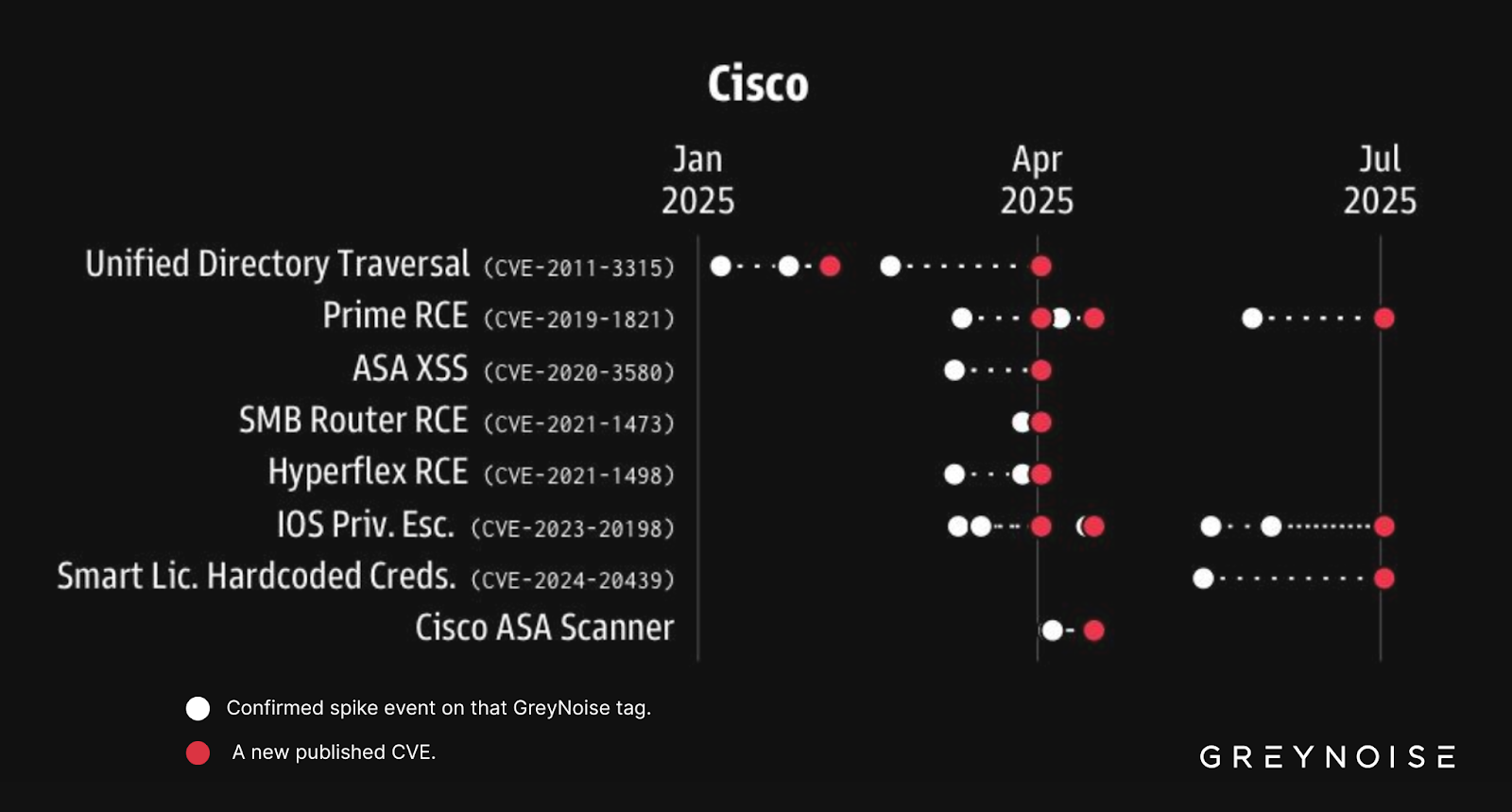
Even if organizations are fully patched, blocking these IPs now may reduce the likelihood of appearing on target lists used to exploit new CVEs in the future.
Monitor GreyNoise’s Cisco ASA tags for real-time scanning and exploitation activity:
GreyNoise will continue monitoring the situation and update this blog as necessary. Concentrated reconnaissance bursts, such as those in August, should be treated as potential early indicators of future vulnerability disclosures.
Please contact your GreyNoise support team if you are interested in the JA4+ signatures in this investigation.
GreyNoise is developing an enhanced dynamic IP blocklist to help defenders take faster action on emerging threats. Click here to learn more or get on the waitlist.
— — —
This research and discovery was a collaborative effort between Towne Besel and Noah Stone.
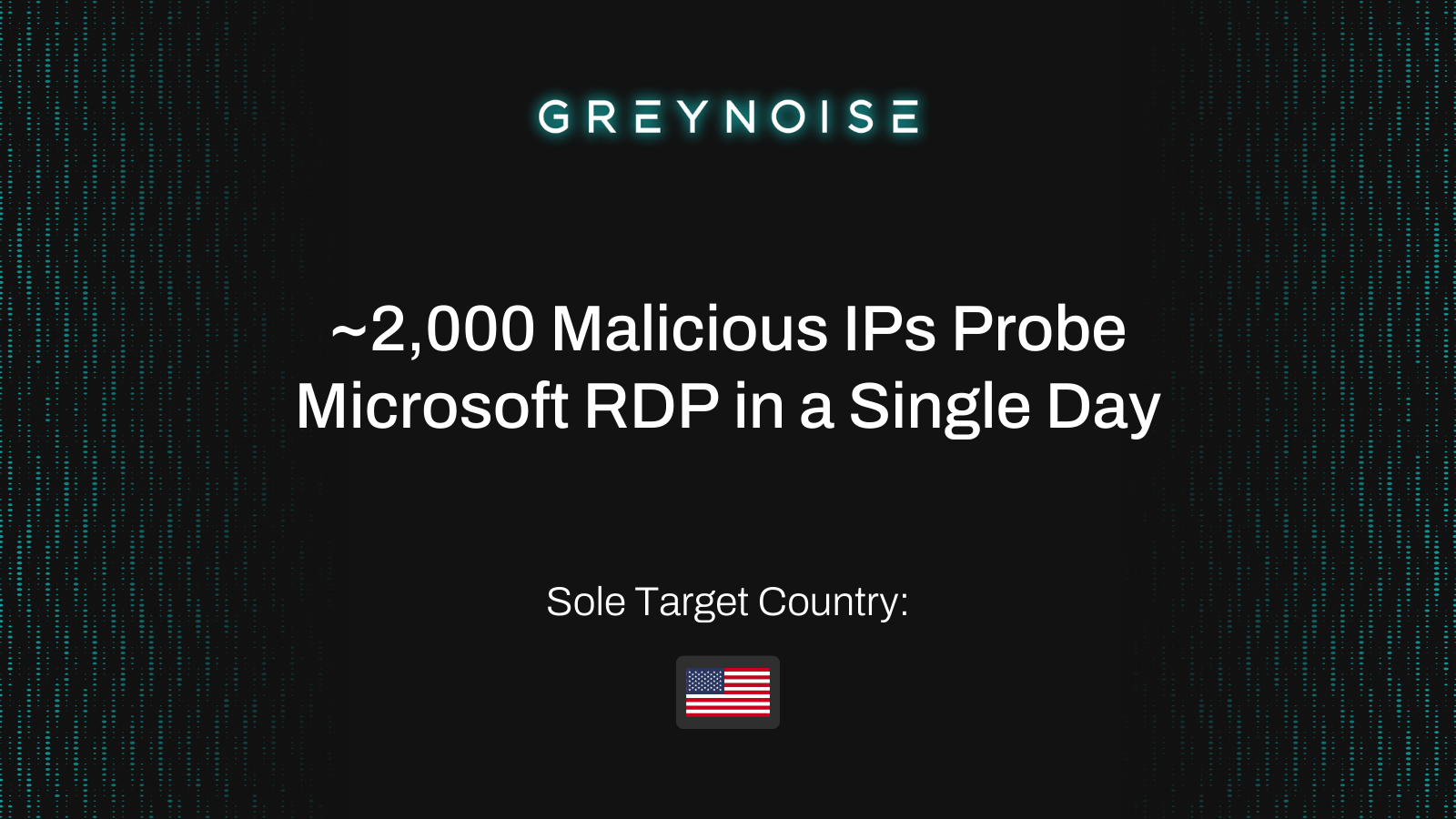
Hours after publishing this blog, GreyNoise identified a much larger wave: on August 24, over 30,000 unique IPs simultaneously triggered both Microsoft RD Web Access and Microsoft RDP Web Client tags, largely from the same client signature behind the August 21 spike we reported below.
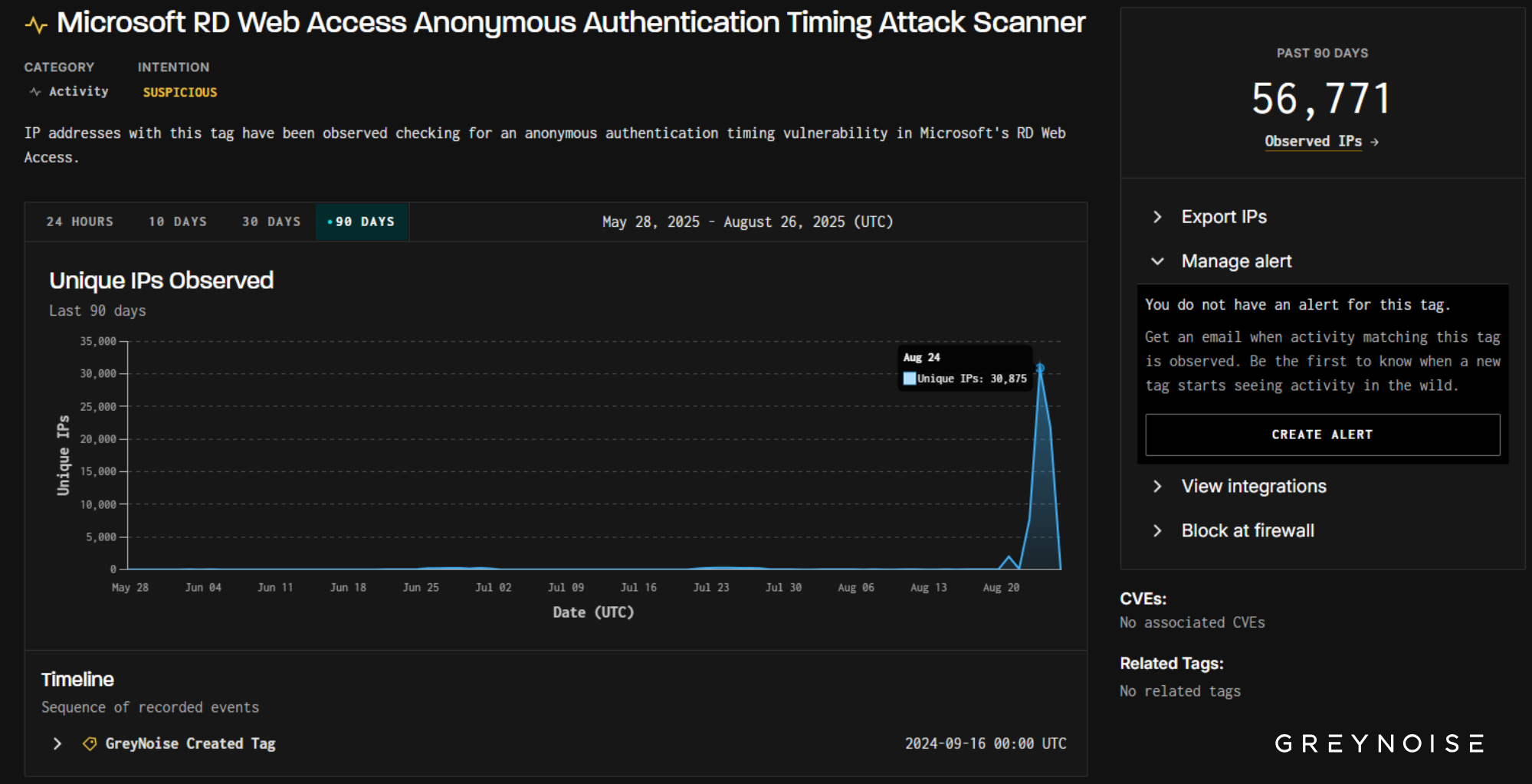
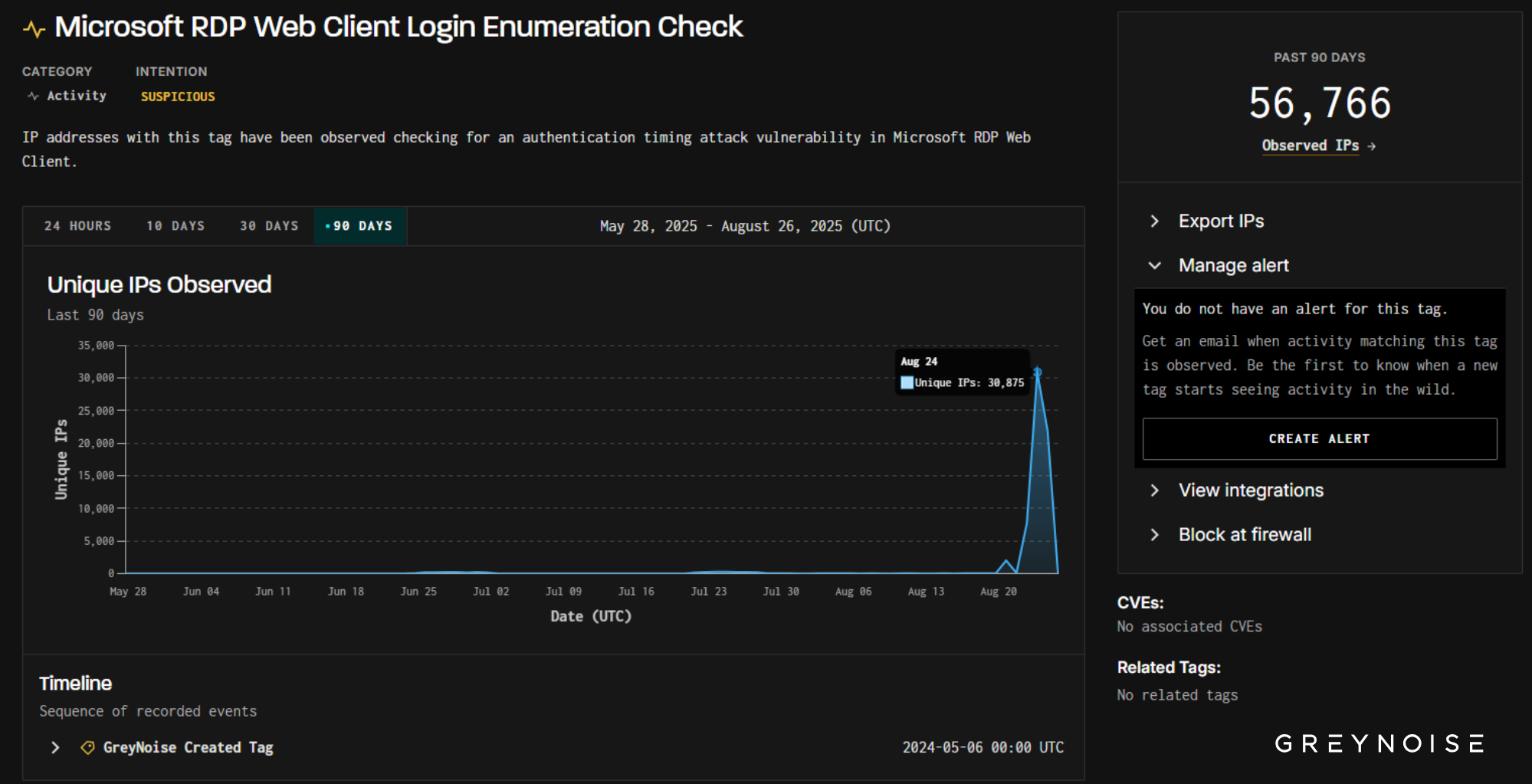
On August 21, GreyNoise observed a sharp surge in scanning against Microsoft Remote Desktop (RDP) services. Nearly 2,000 IPs — the vast majority previously observed and tagged as malicious — simultaneously probed both Microsoft RD Web Access and Microsoft RDP Web Client authentication portals. The wave’s aim was clear: test for timing flaws that reveal valid usernames, laying the groundwork for credential-based intrusions.
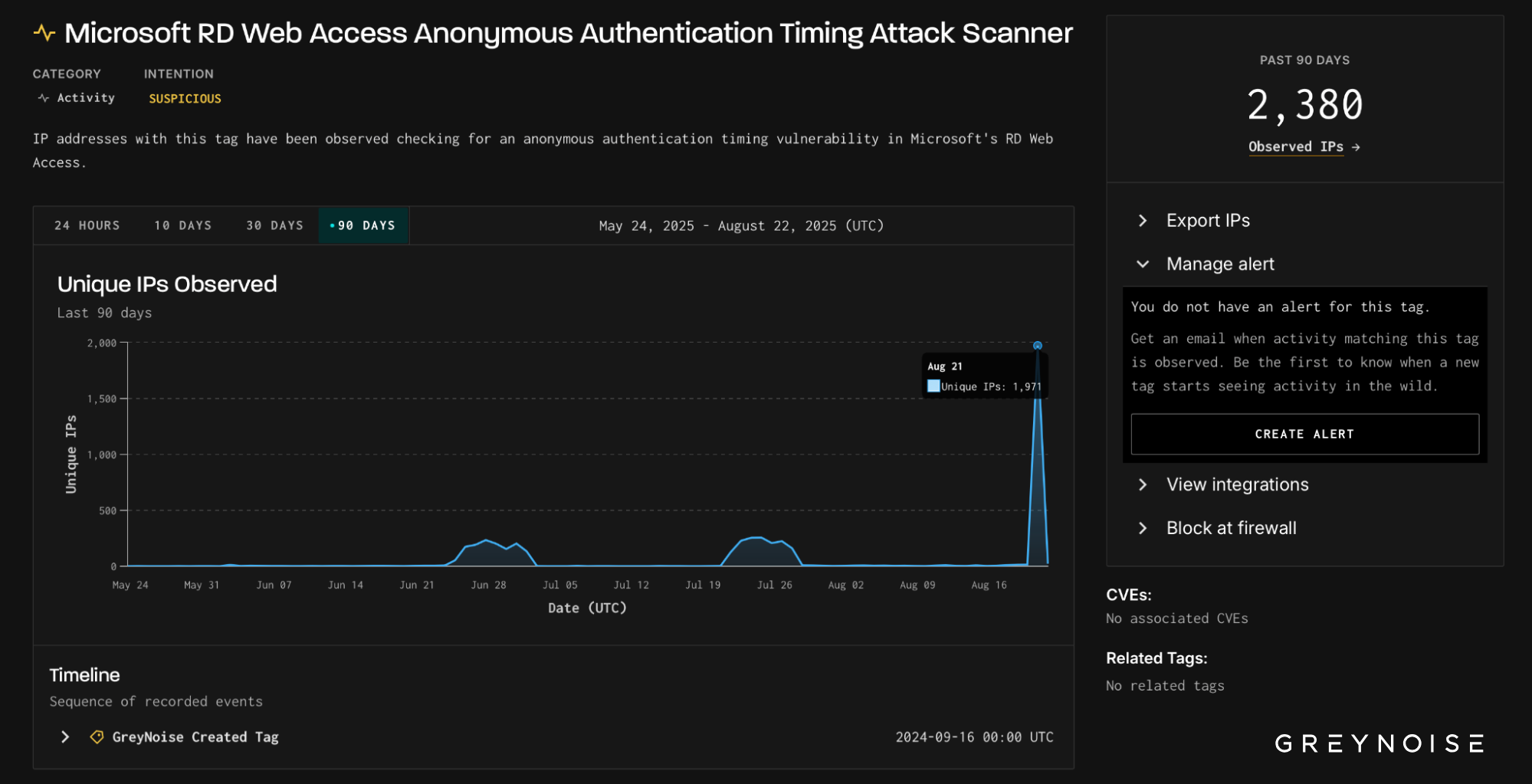

Separately but potentially relevant, on August 22 GreyNoise observed a spike in scanning for open proxies. This heightened activity follows recent anomalies observed on July 31 and August 9 against GreyNoise’s Open Proxy Scanner tag. Early research indicates there is partial overlap in client signatures between this spike and the RDP scan detected on August 21.
The timing may not be accidental. August 21 sits squarely in the US back-to-school window, when universities and K-12 bring RDP-backed labs and remote access online and onboard thousands of new accounts. These environments often use predictable username formats (student IDs, firstname.lastname), making enumeration more effective. Combined with budget constraints and a priority on accessibility during enrollment, exposure could spike.
The campaign’s US-only targeting aligns with that calendar — education and IT teams should harden RDP now and watch for follow-up activity from this same client signature.
The RDP scanners were doing more than just touching login pages:
This is enumeration: confirming accounts on exposed systems so later credential stuffing, password spraying, or brute force has a much higher chance of success.
A large, uniform, maliciously-classified scanner set is actively mapping Microsoft RDP authentication surfaces for account discovery weaknesses. Even without immediate exploitation, the output of this campaign (which endpoints exist, which accounts likely exist) is directly reusable for:
Recent research found spikes in attacker activity against a given technology tend to precede new vulnerabilities in that technology. In 80 percent of cases, a new vulnerability emerged within six weeks of a spike.
RDP has been leveraged by threat actors in the past to conduct espionage, deploy ransomware, and run global exploit campaigns:
GreyNoise will continue monitoring the situation and update this blog as necessary.
Please contact your GreyNoise support team if you are interested in the JA4+ signatures in this investigation.
GreyNoise is developing an enhanced dynamic IP blocklist to help defenders take faster action on emerging threats. Click here to learn more or get on the waitlist.
— — —
Stone is Head of Content at GreyNoise Intelligence, where he leads strategic content initiatives that illuminate the complexities of internet noise and threat intelligence. In past roles, he led partnered research initiatives with Google and the U.S. Department of Homeland Security. With a background in finance, technology, and engagement with the United Nations on global topics, Stone brings a multidimensional perspective to cybersecurity. He is also affiliated with the Council on Foreign Relations.

On August 3, GreyNoise observed a significant spike in brute-force traffic targeting Fortinet SSL VPNs. Over 780 unique IPs triggered our Fortinet SSL VPN Bruteforcer tag in a single day — the highest single-day volume we’ve seen on this tag in recent months.
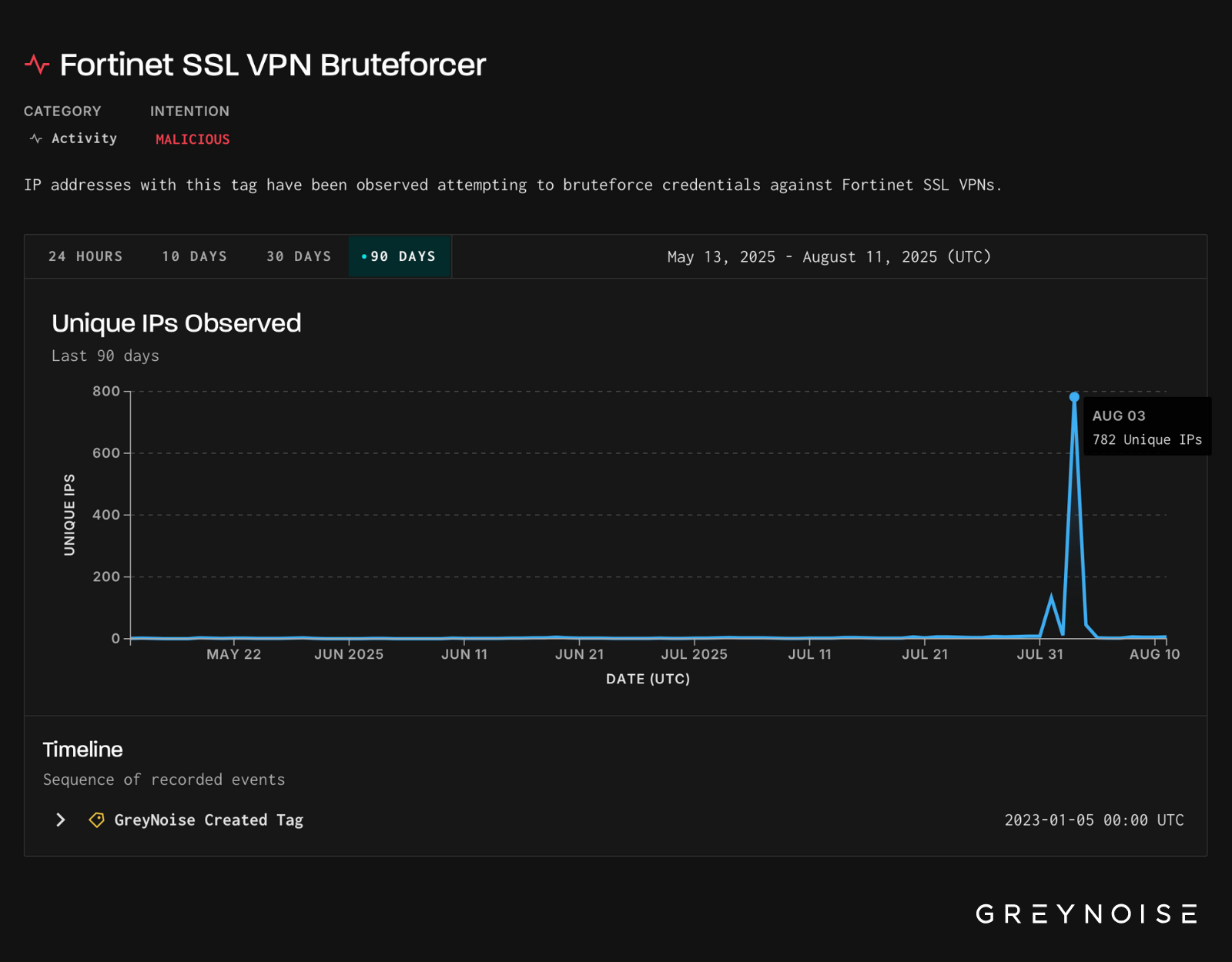
New research shows spikes like this often precede the disclosure of new vulnerabilities affecting the same vendor — most within six weeks. In fact, GreyNoise found that spikes in activity triggering this exact tag are significantly correlated with future disclosed vulnerabilities in Fortinet products. The below chart shows spikes in activity against Fortinet tags (white dots) and CVE disclosures affecting Fortinet products (red dots):
.png)
Critically, the observed traffic was also targeting our FortiOS profile, suggesting deliberate and precise targeting of Fortinet’s SSL VPNs. This was not opportunistic — it was focused activity.
The top target countries in the past 90 days are Hong Kong and Brazil.
When we reviewed a two week window of traffic matching the Fortinet SSL VPN Bruteforcer tag, two distinct waves emerged:
This made the decision easy: we pivoted to the second wave to learn more.
Once the TCP signature for the second wave was isolated, we paired it with an observed client signature seen in sessions during the same timeframe.
What we found was surprising.
While the August 3 traffic has targeted the FortiOS profile, traffic fingerprinted with TCP and client signatures — a meta signature — from August 5 onward was not hitting FortiOS. Instead, it was consistently targeting our FortiManager - FGFM profile albeit still triggering our Fortinet SSL VPN Bruteforcer tag.
This indicated a shift in attacker behavior — potentially the same infrastructure or toolset pivoting to a new Fortinet-facing service.
IPs associated with the meta signature:
31.206.51.194
23.120.100.230
96.67.212.83
104.129.137.162
118.97.151.34
180.254.147.16
20.207.197.237
180.254.155.227
185.77.225.174
45.227.254.113
One additional lead emerged during the investigation.
When reviewing historical data tied to the same post-August 5 TCP fingerprint, we found an earlier spike in June with a unique client signature that resolved to an IP — a FortiGate device — in a residential ISP block (Pilot Fiber Inc.). This may indicate that the brute-force tooling was initially tested or launched from a home network — or it could reflect use of a residential proxy. A quick search of the device revealed:
Notably, traffic tied to that same client signature in June was later seen paired with the same TCP signature associated with the longer-running brute-force cluster (Wave One) mentioned earlier. This overlap doesn’t confirm attribution, but it suggests possible reuse of tooling or network environments. Simply put, this side quest led us back to the original traffic associated with the August 3 spike.
Use GreyNoise to:
Please contact your GreyNoise support team if you are interested in the JA4+ signatures in this investigation.
GreyNoise will continue monitoring the situation and provide updates as necessary.
GreyNoise is developing an enhanced dynamic IP blocklist to help defenders take faster action on emerging threats. Click here to learn more or get on the waitlist.
— — —
This research and discovery was a collaborative effort between Towne Besel and Noah Stone.

In today’s threat landscape, speed isn’t optional — it’s existential. As attacks get faster, so too must your defense.
Attackers increasingly leverage automation, AI, and vast, ephemeral infrastructure to launch mass exploitation campaigns that scan, breach, and pivot within minutes — sometimes before a CVE is even publicly disclosed. Defenders, meanwhile, are often stuck pulling data manually, querying APIs, or waiting for threat feeds to update.
That’s the speed gap that attackers exploit. Today, we're launching a series of new capabilities to help defenders close that gap. These new capabilities help security teams leverage real-time threat intel to detect, block, and respond faster than ever before
The game has changed:
Yet many defenders still operate in batch mode: querying APIs, pulling feeds manually, or reacting only after the damage is done. GreyNoise is flipping that script. We’re giving defenders real-time, automation-ready intelligence — designed to meet the speed, volume, and precision required by modern security teams.
Stop mass exploitation at the edge — before it gets in.
GreyNoise-verified malicious IPs involved in opportunistic reconnaissance and exploitation are delivered in real time, designed to be integrated directly into your perimeter defenses.
Use it to:
Threat intelligence that comes to you — automatically.
Say goodbye to the delays caused by polling APIs. Our new push-based data delivery means GreyNoise intelligence is streamed directly to your systems via webhooks — the moment we detect something new.
In security, minutes (even seconds) matter. Push-based intelligence closes the speed gap between attack and defense.
From detection to action — with zero manual steps.
GreyNoise now integrates natively with leading SOAR platforms–such as Splunk SOAR, Palo Alto Networks XSOAR, IBM QRadar SOAR–to help teams turn intelligence into action, instantly and automatically.
Automate key workflows like:
The result:
These launches are part of GreyNoise’s commitment to empowering defenders with:
These new capabilities are built for:
GreyNoise is building the future of threat intelligence for defenders who don’t have time to wait.
Meet with us at Black Hat 2025 to learn more — or get started today.
.png)
It’s well known that the window between CVE disclosure and active exploitation has narrowed. But what happens before a CVE is even disclosed?
In our latest research “Early Warning Signals: When Attacker Behavior Precedes New Vulnerabilities,” GreyNoise analyzed hundreds of spikes in malicious activity — scanning, brute forcing, exploit attempts, and more — targeting edge technologies. We discovered a consistent and actionable trend: in the vast majority of cases, these spikes were followed by the disclosure of a new CVE affecting the same technology within six weeks.
This recurring behavior led us to ask:
Could attacker activity offer defenders an early warning signal for vulnerabilities that don’t exist yet — but soon will?
Across 216 spikes observed across our Global Observation Grid (GOG) since September 2024, we found:
Exploit activity may be more than what it seems. Some spikes appear to reflect reconnaissance or exploit-based inventorying. Others may represent probing that ultimately results in new CVE discovery. Either way, defenders can take action.
Blocking attacker infrastructure involved in these spikes may reduce the chances of being inventoried — and ultimately targeted — when a new CVE emerges. Just as importantly, these trends give CISOs and security leaders a credible reason to harden defenses, request additional resources, or prepare strategic responses based on observable signals — not just after a CVE drops, but weeks before.
The full report includes:
This research builds on our earlier work on resurgent vulnerabilities, offering a new lens for defenders to track vulnerability risk based on what attackers do — not just what’s been disclosed.
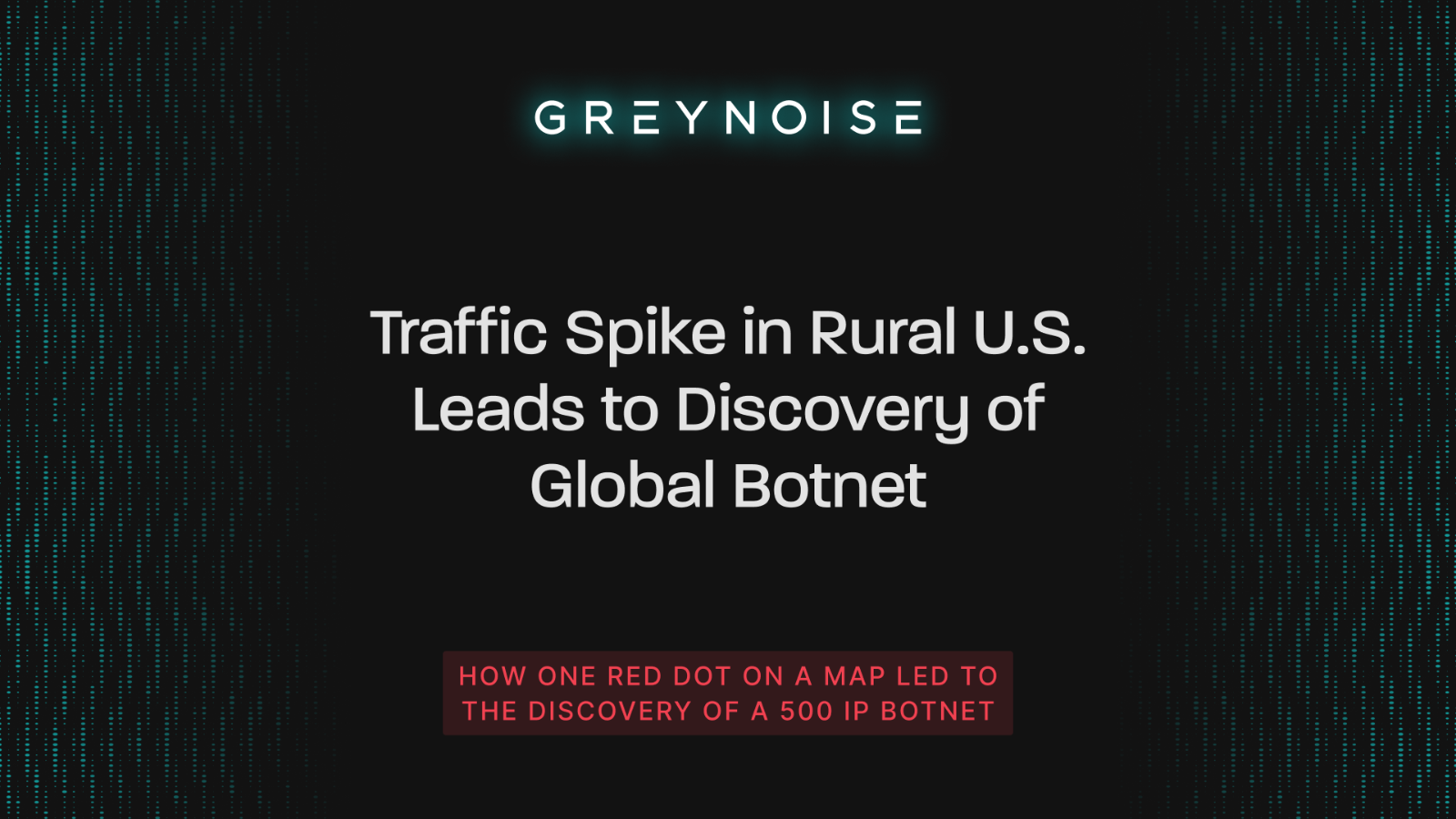
One of our engineers was reviewing our telemetry dashboard when he came across something unusual:
A tight cluster of red dots — each one representing a malicious IP — lighting up a rural patch of New Mexico:
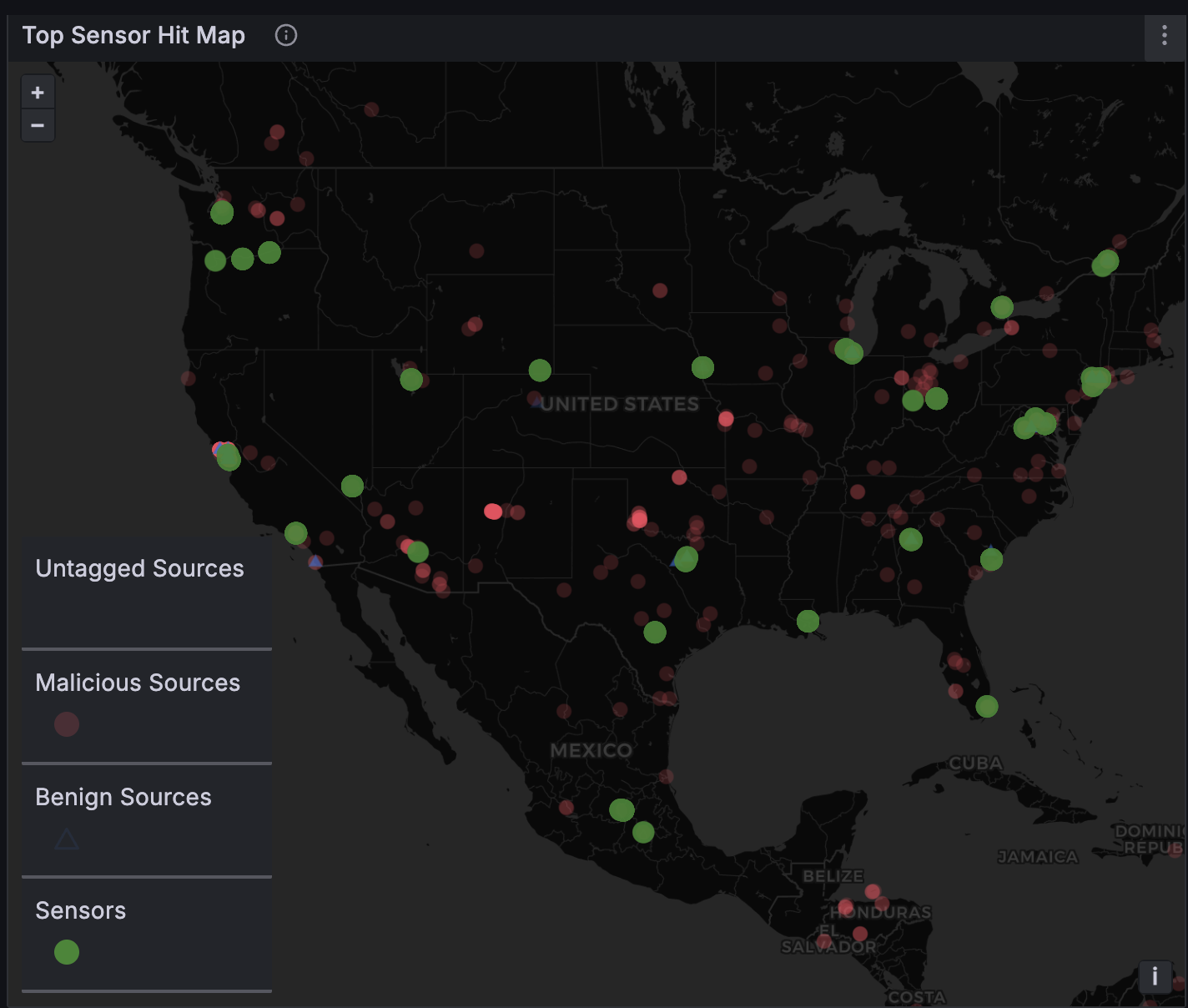
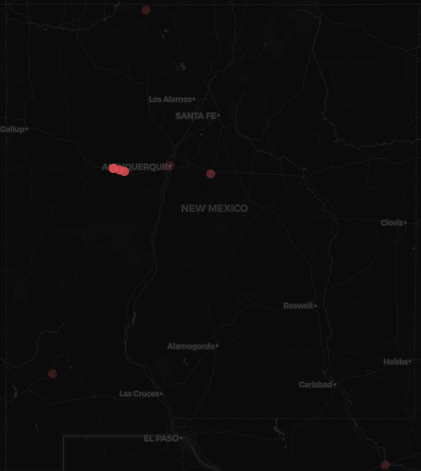
Nothing unusual about botnet traffic. But this time, dozens of malicious IPs were all coming from a single region with a population of just over 3,000 people.
It didn’t fit the pattern. So we dug in.
We zoomed into the map and picked up the first IP: 137.118.82.76.
It had a troubling combination of GreyNoise tags:
This wasn’t just a misconfigured device — it looked like a system actively participating in a botnet.
So we pulled the thread.
Zooming out, we found ~90 IPs in the same New Mexico region, all tied to a single provider: Pueblo of Laguna Utility Authority.
100% of this traffic was Telnet-based.
To dig deeper, we used our internal tooling — including the GreyNoise Model Context Protocol (MCP) server (an AI-powered analysis environment) — to iterate quickly on investigation paths.
We fed IP metadata and network behavior into Claude, exploring ideas in real time. We then used Censys infrastructure data and tshark packet captures to enrich the dataset.
This AI-powered analysis helped confirm that many of the systems were VOIP-enabled devices.
While we did not identify exact device models for each system, enrichment suggested hardware from Cambium Networks was likely involved in a portion of the activity.
It wasn’t a one-off misconfiguration — it appeared to be a coordinated cluster of similar systems likely running comparable stacks.
After confirming the localized activity, we widened the investigation.
Using GreyNoise tags, behavioral similarity, and Telnet traffic patterns, we identified about 500 IPs globally exhibiting similar traits:
Some of these IPs were linked to VOIP-capable devices and shared similar infrastructure characteristics — suggesting a wider class of exposed systems is being targeted for botnet activity.
VOIP devices often run on older Linux-based firmware, sometimes with Telnet exposed by default. They’re also frequently:
Some Cambium routers, for example, may still be running firmware versions impacted by a known remote code execution (RCE) vulnerability from 2017.
While we did not confirm exploitation of that CVE in this case, the activity reinforces a broader point: Vulnerabilities remain part of the attack surface long after disclosure.
We recently explored this dynamic in our latest report on resurgent vulnerabilities, where we highlight how long-patched flaws in edge devices are repeatedly targeted.
Shortly after a member of our team posted a brief mention of the activity on social media, the traffic from the New Mexico utility dropped off — completely.
Whether coincidence or evidence that attackers monitor visibility, it was a sharp cutoff.
And shortly after that, activity spiked yet again and the global behavior continued.
What started as a spike from a single utility in a rural part of the United States became a lens into an ongoing global pattern — one defenders should track closely.
GreyNoise is developing an enhanced dynamic IP blocklist to help defenders take faster action on emerging threats. Click here to learn more or get on the waitlist.
---
This investigation was sparked by GreyNoise’s keen-eyed Lead Software Engineer Jeff Golden, with contributions from the broader GreyNoise research team.
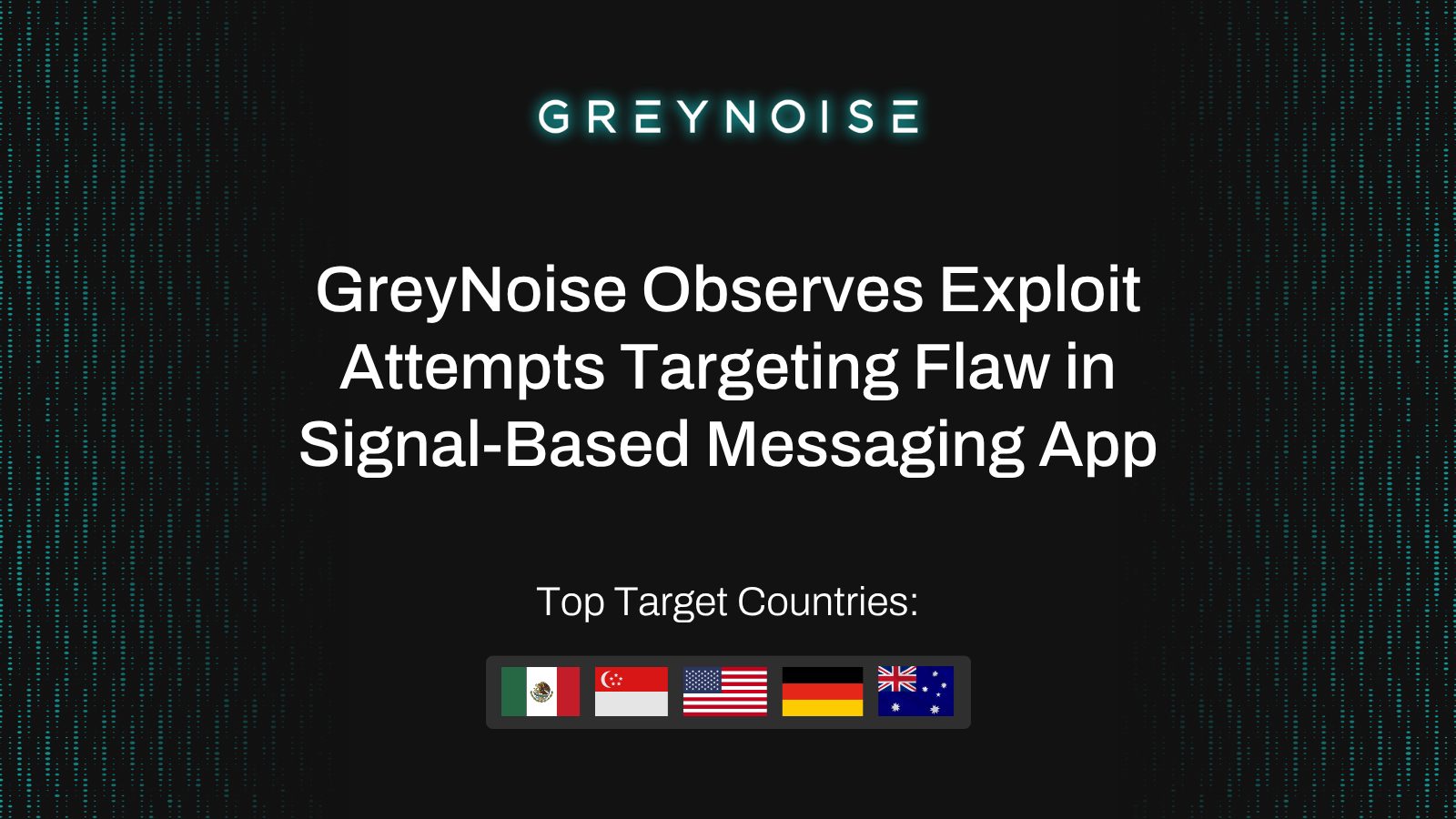
GreyNoise has received a statement from TeleMessage, stating:
CVE-2025-48927 was fully remediated in the TeleMessage environment in early May. That remediation has been independently verified by our third-party cybersecurity partner. As a cloud-native SaaS platform, all fixes were applied centrally, and no action was required by customers. As such, any attempts to exploit CVE-2025-48927 since that time have been unsuccessful.
A vulnerability disclosed in May 2025, CVE-2025-48927, affects certain deployments of TeleMessageTM SGNL, an enterprise messaging system modeled after Signal, used by government agencies and enterprises alike to archive secure communications. The issue stems from the platform’s continued use of a legacy confirmation in Spring Boot Actuator, where a diagnostic /heapdump endpoint is publicly accessible without authentication.
If exposed, this endpoint can return a full snapshot of heap memory — roughly 150MB — which may include plaintext usernames, passwords, and other sensitive data. While newer versions of Spring Boot no longer expose this endpoint by default, public reporting indicates that TeleMessage instances continued using the older, insecure configuration through at least May 5, 2025.
On July 14th, CVE-2025-48927 was added to CISA’s Known Exploited Vulnerabilities (KEV) catalog.
See GreyNoise’s technical writeup here.
As of July 16, GreyNoise has observed 11 IPs attempting to exploit CVE-2025-48927 (tag created July 10).
Related reconnaissance behavior is ongoing. Our telemetry shows active scanning for Spring Boot Actuator endpoints — a potential precursor to identifying systems affected by CVE-2025-48927.
Organizations using Spring Boot — particularly in internal tools or secure messaging environments — should verify whether the /heapdump endpoint is exposed to the internet.
GreyNoise will continue monitoring for shifts in scanning behavior and provide updates if exploitation begins.
GreyNoise is developing an enhanced dynamic IP blocklist to help defenders take faster action on emerging threats. Click here to learn more or get on the waitlist.
---
This analysis was led by GreyNoise Researcher Howdy Fisher.
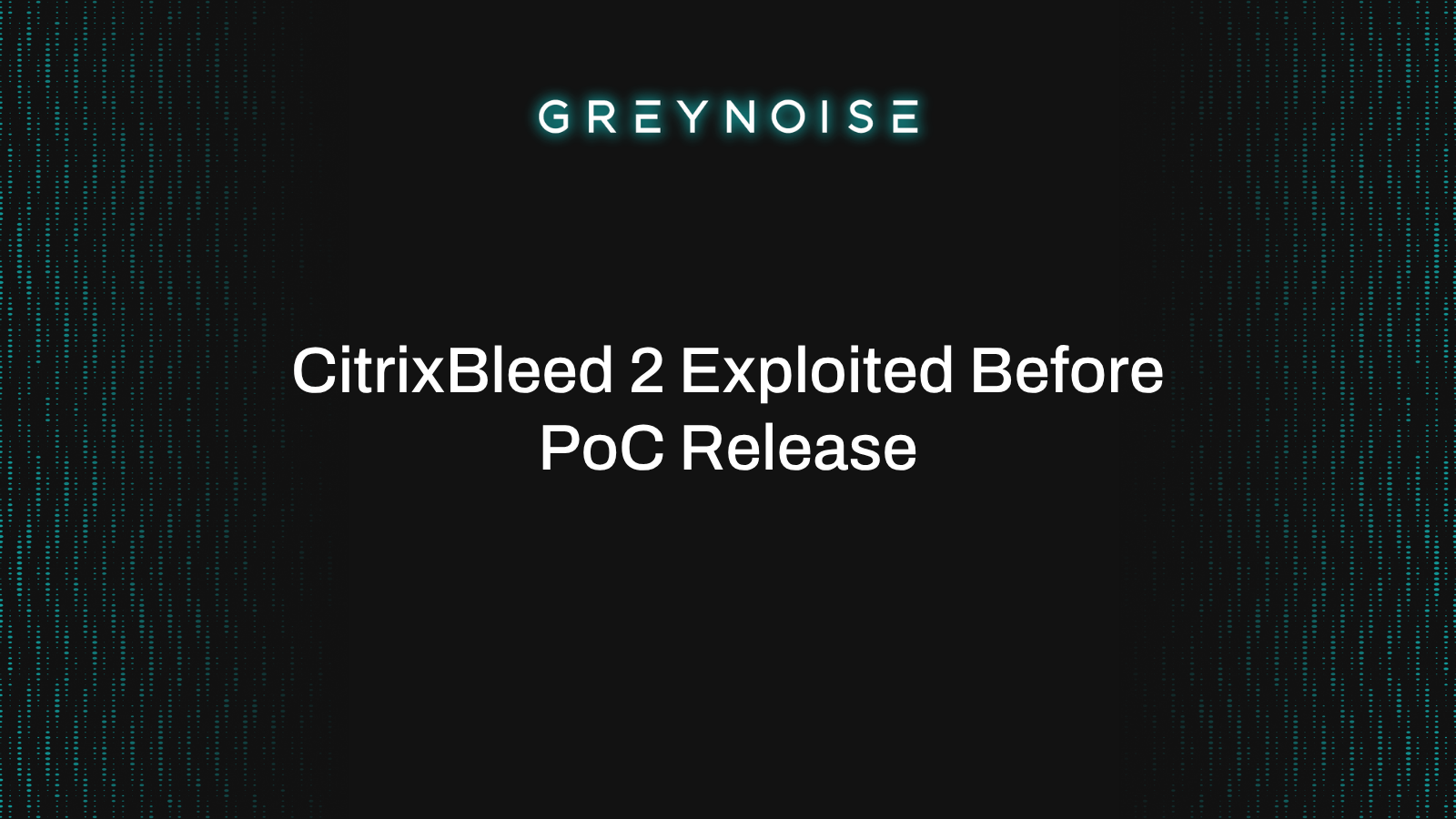
GreyNoise has observed active exploitation attempts against CVE-2025-5777 (CitrixBleed 2), a memory overread vulnerability in Citrix NetScaler. Exploitation began on June 23 — nearly two weeks before a public proof-of-concept (PoC) was released on July 4.
We created a tag on July 7 to track this activity. Because GreyNoise retroactively associates pre-tag traffic with new tags, prior exploitation attempts are now visible in the GreyNoise Visualizer.
.png)
Early exploitation attempts came from malicious IPs geolocated in China. Rather than exploiting indiscriminately, these IPs targeted GreyNoise sensors configured to emulate Citrix NetScaler appliances, suggesting deliberate targeting.
On July 9, shortly after we published the tag, CISA contacted GreyNoise to confirm exploitation activity. CVE-2025-5777 was subsequently added to the Known Exploited Vulnerabilities (KEV) catalog.
Defenders can dynamically block malicious IPs to reduce exposure and suppress alerts.
The above list will stay updated as new IPs are observed attempting to exploit CVE-2025-5777.
GreyNoise is developing an enhanced dynamic IP blocklist to help defenders take faster action on emerging threats. Click here to learn more or get on the waitlist.
— — —
Stone is Head of Content at GreyNoise Intelligence, where he leads strategic content initiatives that illuminate the complexities of internet noise and threat intelligence. In past roles, he led partnered research initiatives with Google and the U.S. Department of Homeland Security. With a background in finance, technology, and engagement with the United Nations on global topics, Stone brings a multidimensional perspective to cybersecurity. He is also affiliated with the Council on Foreign Relations.

GreyNoise has identified a previously untracked variant of a scraper botnet, detectable through a globally unique network fingerprint. While the botnet uses a simple and easily spoofed user-agent string — Hello-World/1.0 — its real signature lies in the behavior of the devices sending the traffic.
To detect it, GreyNoise analysts created a signature using JA4+, the suite of JA4 signatures used to fingerprint network traffic. This approach allows analysts to detect traffic based not on what it claims to be, but how it behaves — making it difficult to evade or spoof.
The signature includes:
These behavioral fingerprints form a meta-signature that is globally unique to this botnet variant.
GreyNoise has detected over 3,600 unique IPs matching this signature, geolocated around the world:

Of these IPs:
Targeted systems are predominantly located in the United States and United Kingdom.
Geographic analysis shows a clear concentration of this botnet’s infrastructure in Taiwan, with:
The dominance of Taiwanese IP space could suggest:
GreyNoise users can track this botnet variant in the Visualizer or via API. We recommend defenders:
GreyNoise is developing an enhanced dynamic IP blocklist to help defenders take faster action on emerging threats. Click here to learn more or get on the waitlist.
This analysis was led by GreyNoise Deception Engineer Towne Besel, who developed the detection signature and conducted the underlying research.

GreyNoise has identified a notable surge in scanning activity targeting MOVEit Transfer systems, beginning on May 27, 2025. Prior to this date, scanning was minimal — typically fewer than 10 IPs observed per day. But on May 27, that number spiked to over 100 unique IPs, followed by 319 IPs on May 28.
Since that initial jump, daily scanner IP volume has remained intermittently elevated between 200 to 300 IPs per day — a significant deviation from baseline and an indicator that MOVEit Transfer is once again in the crosshairs.

These patterns often coincide with new vulnerabilities emerging two to four weeks later.
GreyNoise also observed low-volume exploitation attempts on June 12, 2025, associated with two previously disclosed MOVEit Transfer vulnerabilities:


These events occurred during the period of heightened scanning and may represent target validation or exploit testing, but at this time, no widespread exploitation has been observed by GreyNoise.
A significant portion of scanner IPs are hosted by a small number of cloud providers:
This level of infrastructure concentration — particularly within a single ASN — suggests that the scanning is deliberate and programmatically managed, rather than random or distributed probing.
Organizations should take the following steps:
1. Dynamically block malicious and suspicious IPs using GreyNoise:
2. Audit public exposure of any MOVEit Transfer systems.
3. Apply patches for known vulnerabilities, including CVE-2023-34362 and CVE-2023-36934.
4. Monitor real-time attacker activity against MOVEit Transfer by navigating to each respective GreyNoise tag:
We will continue to monitor the situation and provide updates as necessary.
GreyNoise is developing an enhanced dynamic IP blocklist to help defenders take faster action on emerging threats. Click here to learn more or get on the waitlist.
— — —
Stone is Head of Content at GreyNoise Intelligence, where he leads strategic content initiatives that illuminate the complexities of internet noise and threat intelligence. In past roles, he led partnered research initiatives with Google and the U.S. Department of Homeland Security. With a background in finance, technology, and engagement with the United Nations on global topics, Stone brings a multidimensional perspective to cybersecurity. He is also affiliated with the Council on Foreign Relations.

On June 16, GreyNoise observed exploit attempts targeting CVE-2023-28771 — a remote code execution vulnerability affecting Zyxel Internet Key Exchange (IKE) packet decoders over UDP port 500.
Exploitation attempts against CVE-2023-28771 were minimal throughout recent weeks. On June 16, GreyNoise observed a concentrated burst of exploit attempts within a short time window, with 244 unique IPs observed attempting exploitation.
The top destination countries were the U.S., U.K., Spain, Germany, and India.
Historical analysis indicates that in the two weeks preceding June 16, these IPs were not observed engaging in any other scanning or exploit behavior — only targeting CVE-2023-28771.

All 244 IP addresses are registered to Verizon Business infrastructure and geolocated to the United States. However, because CVE-2023-28771 is exploited over UDP (port 500), spoofing is possible and these IPs may not reflect the true source of the traffic.
Deeper analysis by GreyNoise identified indicators consistent with Mirai botnet variants, as confirmed by VirusTotal. Example payload, and IP metadata below:


GreyNoise is developing an enhanced dynamic IP blocklist to help defenders take faster action on emerging threats. Click here to learn more or get on the waitlist.
— — —
Stone is Head of Content at GreyNoise Intelligence, where he leads strategic content initiatives that illuminate the complexities of internet noise and threat intelligence. In past roles, he led partnered research initiatives with Google and the U.S. Department of Homeland Security. With a background in finance, technology, and engagement with the United Nations on global topics, Stone brings a multidimensional perspective to cybersecurity. He is also affiliated with the Council on Foreign Relations.

GreyNoise recently observed a coordinated spike in malicious activity against Apache Tomcat Manager interfaces. On June 5, 2025, two GreyNoise tags — Tomcat Manager Brute Force Attempt and Tomcat Manager Login Attempt — registered well above baseline volumes, indicating a deliberate attempt to identify and access exposed Tomcat services at scale.


Roughly 400 unique IPs were involved in the activity observed across both tags during this period of elevated activity. Most of the activity originating from these IPs exhibited a narrow focus on Tomcat services.
A significant portion of this activity originated from infrastructure hosted by DigitalOcean (ASN 14061).
Immediately block the malicious IPs engaged in this activity.
While not tied to a specific vulnerability, this behavior highlights ongoing interest in exposed Tomcat services. Broad, opportunistic activity like this often serves as an early warning of future exploitation.
Organizations with Tomcat Manager interfaces accessible over the internet should verify that strong authentication and access restrictions are in place. Reviewing recent login activity for anomalies is also advised.
GreyNoise will continue monitoring for shifts in behavior or signs of follow-on exploitation. Subscribe to the GreyNoise Blog for updates.
GreyNoise is developing an enhanced dynamic IP blocklist to help defenders take faster action on emerging threats. Click here to learn more or get on the waitlist.
— — —
Stone is Head of Content at GreyNoise Intelligence, where he leads strategic content initiatives that illuminate the complexities of internet noise and threat intelligence. In past roles, he led partnered research initiatives with Google and the U.S. Department of Homeland Security. With a background in finance, technology, and engagement with the United Nations on global topics, Stone brings a multidimensional perspective to cybersecurity. He is also affiliated with the Council on Foreign Relations.
.png)
This activity was first discovered by GreyNoise on March 18, 2025. Public disclosure was deferred as we coordinated the findings with government and industry partners.
GreyNoise has identified an ongoing exploitation campaign in which attackers have gained unauthorized, persistent access to thousands of ASUS routers exposed to the internet. This appears to be part of a stealth operation to assemble a distributed network of backdoor devices — potentially laying the groundwork for a future botnet.
The tactics used in this campaign — stealthy initial access, use of built-in system features for persistence, and careful avoidance of detection — are consistent with those seen in advanced, long-term operations, including activity associated with advanced persistent threat (APT) actors and operational relay box (ORB) networks. While GreyNoise has made no attribution, the level of tradecraft suggests a well-resourced and highly capable adversary.
The attacker’s access survives both reboots and firmware updates, giving them durable control over affected devices. The attacker maintains long-term access without dropping malware or leaving obvious traces by chaining authentication bypasses, exploiting a known vulnerability, and abusing legitimate configuration features.
The activity was uncovered by Sift — GreyNoise’s proprietary AI-powered network payload analysis tool — in combination with fully emulated ASUS router profiles running in the GreyNoise Global Observation Grid. These tools enabled us to detect subtle exploitation attempts buried in global traffic and reconstruct the full attack sequence.
Read the full technical analysis.
March 17, 2025: GreyNoise’s proprietary AI technology, Sift, observes anomalous traffic.
March 18, 2025: GreyNoise researchers become aware of Sift report and begin investigating.
March 23, 2025: Disclosure deferred as we coordinated the findings with government and industry partners.
May 22, 2025: Sekoia announces compromise of ASUS routers as part of ‘ViciousTrap.’
May 28, 2025: GreyNoise publishes this blog.
The campaign was surfaced by Sift, GreyNoise’s AI-powered analysis tool for detecting novel and anomalous network activity. Sift flagged just three HTTP POST requests — targeting ASUS router endpoints — for deeper inspection.
These payloads were only observed on our fully emulated ASUS profiles running factory firmware. This infrastructure allowed GreyNoise to:
Without emulated profiles and deep inspection, this attack would likely have remained invisible. The attacker disables logging and uses official router features, leaving few traces.
IP addresses involved in this activity:
101.99.91.151
101.99.94.173
79.141.163.179
111.90.146.237
Backdoor port:
TCP/53282
Attacker SSH public key (truncated):
ssh-rsa AAAAB3NzaC1yc2EAAAABIwAAAQEAo41nBoVFfj4HlVMGV+YPsxMDrMlbdDZ...
If a router was compromised before updating, the backdoor will still be present unless SSH access is explicitly reviewed and removed.
For payload details, firmware analysis, and attack reconstruction:
Read the full technical analysis.
GreyNoise is developing an enhanced dynamic IP blocklist to help defenders take faster action on emerging threats. Click here to learn more or get on the waitlist.

On May 8, GreyNoise observed a highly coordinated reconnaissance campaign launched by 251 malicious IP addresses, all geolocated to Japan and hosted by Amazon AWS. Over the span of a single day, these IPs triggered 75 distinct scanning behaviors, each tracked by a GreyNoise tag — ranging from exploitation attempts for known CVEs to probes for misconfigurations and weak points in web infrastructure.
This operation was opportunistic — as is all scanning observed by GreyNoise — but the infrastructure and execution suggest centralized planning. Every IP was active only on May 8, with no noticeable activity immediately before or after, indicating temporary use of cloud infrastructure rented specifically for this operation.
Some of the behaviors observed included exploit attempts for:
These CVEs, while disclosed years ago, continue to attract interest from opportunistic attackers — a pattern explored in our latest research, which tracks the return of long-disclosed flaws to the threat landscape.
The 251 IPs collectively triggered 75 distinct scanning behaviors, including:
This wasn’t an operation focused on one exploit or tech stack. It reflected a broad-spectrum search for any exposed system — particularly older edge infrastructure that may be overlooked in patch cycles.
The 2025 Verizon DBIR revealed the edge as a critical risk, reporting concerning trends across time-to-mass-exploit and remediation lags in edge technologies.
GreyNoise analysis revealed the following:
This level of overlap points to a single operator or toolset deployed across many temporary IPs — an increasingly common pattern in opportunistic but orchestral scanning.
GreyNoise has compiled the full list of all 251 malicious IPs observed in this operation.
13.112.127.102,13.112.137.152,13.112.240.11,13.112.5.89,13.112.69.56,13.113.0.143,13.113.184.40,13.113.217.149,13.114.127.223,13.114.149.129,13.114.218.63,13.114.31.226,13.114.60.193,13.114.98.0,13.115.180.180,13.115.202.46,13.115.229.240,13.115.2.3,13.115.69.54,13.115.71.29,13.230.129.147,13.230.147.105,13.230.225.215,13.230.233.152,13.230.5.184,13.230.8.99,13.230.96.118,13.231.106.81,13.231.146.138,13.231.146.225,13.231.146.246,13.231.153.70,13.231.174.40,13.231.179.96,13.231.184.66,13.231.185.166,13.231.189.33,13.231.191.131,13.231.212.197,13.231.213.253,13.231.214.67,13.231.224.0,13.231.232.177,13.231.232.45,13.231.41.82,13.231.5.78,175.41.228.130,18.176.55.146,18.176.59.175,18.177.143.78,18.177.146.44,18.179.142.39,18.179.197.80,18.179.198.67,18.179.206.138,18.179.30.23,18.179.45.108,18.179.45.73,18.179.46.150,18.179.46.189,18.179.61.223,18.181.212.31,18.182.15.49,18.182.26.23,18.182.9.108,18.182.9.65,18.183.102.143,18.183.102.157,18.183.105.164,18.183.131.125,18.183.165.137,18.183.168.179,18.183.168.64,18.183.176.53,18.183.186.98,18.183.208.224,18.183.213.115,18.183.221.123,18.183.225.18,18.183.229.102,18.183.233.113,18.183.245.235,18.183.248.39,18.183.75.21,18.183.80.208,3.112.124.171,3.112.131.166,3.112.14.18,3.112.150.85,3.112.18.153,3.112.18.248,3.112.203.162,3.112.208.32,3.112.211.126,3.112.218.237,3.112.227.46,3.112.231.205,3.112.233.225,3.112.235.102,3.112.238.114,3.112.253.75,3.112.26.102,3.112.28.119,3.112.32.198,3.112.32.225,3.112.5.87,3.113.0.228,3.113.0.28,3.113.15.97,3.113.25.14,3.113.32.74,35.72.14.113,35.72.14.164,35.72.4.135,35.72.9.173,35.77.105.104,35.77.90.69,35.77.93.26,43.206.215.21,43.206.231.122,43.206.234.13,43.206.235.211,43.206.253.231,43.207.0.130,43.207.103.240,43.207.105.145,43.207.115.43,43.207.118.103,43.207.1.24,43.207.139.186,43.207.150.212,43.207.155.29,43.207.155.87,43.207.166.102,43.207.170.51,43.207.191.167,43.207.198.203,43.207.201.71,43.207.202.54,43.207.203.44,43.207.225.86,43.207.232.1,43.207.232.100,43.207.3.58,43.207.74.241,43.207.79.249,43.207.81.76,52.192.111.156,52.192.125.55,52.192.14.49,52.192.27.19,52.192.56.196,52.192.99.140,52.194.205.49,52.194.220.244,52.194.248.125,52.194.250.54,52.194.254.213,52.195.11.174,52.195.12.82,52.195.171.70,52.195.177.128,52.195.181.143,52.195.183.23,52.195.189.155,52.195.189.78,52.195.194.167,52.195.207.5,52.195.208.52,52.195.209.222,52.195.211.238,52.195.218.94,52.195.221.157,52.195.3.244,52.195.8.164,52.197.210.229,52.199.10.181,52.199.149.12,52.199.199.160,52.199.253.240,52.199.8.84,52.68.188.9,52.68.94.94,52.69.157.91,52.69.46.191,54.150.219.131,54.168.241.135,54.168.247.234,54.168.71.21,54.178.0.190,54.178.114.236,54.178.4.74,54.178.5.144,54.199.101.111,54.199.161.31,54.199.176.59,54.199.40.192,54.199.77.18,54.199.94.62,54.238.101.236,54.238.147.176,54.238.179.56,54.238.189.57,54.238.237.183,54.238.237.9,54.238.4.12,54.238.80.76,54.248.152.214,54.248.156.216,54.248.201.195,54.248.36.134,54.249.121.50,54.249.133.28,54.249.155.117,54.249.219.65,54.249.26.220,54.250.153.158,54.250.161.184,54.250.16.51,54.250.188.209,54.250.237.20,54.250.241.63,54.250.244.142,54.250.244.229,54.250.33.160,54.250.33.94,54.65.130.227,54.65.45.54,54.95.18.182,54.95.193.225,54.95.23.202,54.95.23.87,54.95.36.237,57.180.10.227,57.180.18.215,57.180.242.12,57.180.246.9,57.180.248.217,57.180.27.121,57.180.35.101,57.180.38.232,57.180.40.26,57.180.41.47,57.180.42.39,57.180.47.171,57.180.47.190,57.180.48.122,57.180.56.170,57.180.9.137,57.181.30.246,57.181.37.146Defenders should block these IPs immediately. While follow-up exploitation may come from different infrastructure, GreyNoise classified all 251 IPs as malicious in real time. Dynamic IP blocking using GreyNoise allows defenses to respond instantly to new scanning infrastructure as it appears, removing guesswork and reducing exposure windows.
Identify which of the 75 GreyNoise tags apply to your environment and dynamically block IPs engaging in that activity.
GreyNoise will continue to monitor this situation and provide updates as necessary.
GreyNoise is developing an enhanced dynamic IP blocklist to help defenders take faster action on emerging threats. Click here to learn more or get on the waitlist.
— — —
Stone is Head of Content at GreyNoise Intelligence, where he leads strategic content initiatives that illuminate the complexities of internet noise and threat intelligence. In past roles, he led partnered research initiatives with Google and the U.S. Department of Homeland Security. With a background in finance, technology, and engagement with the United Nations on global topics, Stone brings a multidimensional perspective to cybersecurity. He is also affiliated with the Council on Foreign Relations.

The bottom line: Two critical Ivanti zero-days (CVE-2025-4427 and CVE-2025-4428) are now being actively exploited after GreyNoise reported a surge in scanning activity against other Ivanti technologies last month. Immediate patching is required.
When chained together, these vulnerabilities enable unauthenticated remote code execution on Ivanti Endpoint Manager Mobile (EPMM) systems. In April, GreyNoise warned about a 9X surge in scanning against Ivanti products — that reconnaissance has now transitioned to exploitation.
How they work: The flaws target the /api/v2/featureusage and /api/v2/featureusage_history endpoints. Input validation occurs before authentication checks, allowing attackers to inject malicious code without credentials.
Credit to Project Discovery and WatchTowr for their excellent technical analysis:
This case demonstrates why monitoring scanning trends provides early warning of attacks. The exploitation activity is currently limited, but will likely accelerate as more threat actors incorporate these vulnerabilities into their toolkits.
Organizations with Portal ACLs or WAF restrictions have reduced exposure, but patching remains the only complete solution.
GreyNoise is developing an enhanced dynamic IP blocklist to help defenders take faster action on emerging threats. Click here to learn more or get on the waitlist.
.png)
The 2025 DBIR highlights a critical area of importance for vulnerability management teams: edge vulnerabilities.
Exploitation of edge vulnerabilities in breaches has surged eightfold. Yet, nearly one in three edge KEVs remain fully unpatched — despite being widely recognized as critical risks.
This isn’t a matter of awareness (they’re on CISA’s KEV). It’s about action and prioritization. Real-time intelligence is a must in this situation, giving insight into what attackers are targeting now — ensuring the most pressing threats are identified and resolved quickly.
This year’s DBIR findings necessitate swift action on the part of defenders, particularly as it relates to edge exploitation.
New findings from the 2025 Verizon Data Breach Investigations Report (DBIR) reveal a critical shift in how attackers breach organizations — and how defenders are simultaneously making strides and falling short:
GreyNoise research reveals a deeper complication: Old edge vulnerabilities are resurging, magnifying the risks defenders face.
Vulnerability exploitation is rising as a breach method — and edge vulnerabilities, in particular, are being exploited far more often to break into organizations.
The Verizon DBIR shows:
Despite heightened attention, edge KEVs remain the most likely vulnerabilities to be left unpatched — even though they are already recognized as critical risks.
This points to a widening gap between risk awareness and defensive action.
The DBIR highlights how quickly attackers exploit vulnerabilities — especially those in edge technologies.
GreyNoise research reveals a deeper problem: attackers also return to older edge vulnerabilities defenders may have deprioritized.
Our research uncovered that resurgent vulnerabilities follow three main attack patterns, visualized as follows (read the full report here):

Static patching models, focused on CISA KEV, CVSS, and EPSS alone, can miss these shifts.
Dynamic, exploitation-driven intelligence can reveal when old vulnerabilities become active risks again — cutting through the complex attack patterns above by relying on near real-time alerts of heightened activity.
Our analysis revealed that half of the top exploited resurgent vulnerabilities affect edge assets — with 70% of Black Swans, the most unpredictable class of resurgent flaws, affecting the edge.

The DBIR and GreyNoise research indicate that edge assets are becoming one of the most attractive targets for attackers.
Today’s edge threat environment demands a new approach:
Read the full report: A Blindspot in Cyber Defense: How Resurgent Vulnerabilities Jeopardize Organizational Security.
— — —
Stone is Head of Content at GreyNoise Intelligence, where he leads strategic content initiatives that illuminate the complexities of internet noise and threat intelligence. In past roles, he led partnered research initiatives with Google and the U.S. Department of Homeland Security. With a background in finance, technology, and engagement with the United Nations on global topics, Stone brings a multidimensional perspective to cybersecurity. He is also affiliated with the Council on Foreign Relations.

GreyNoise observed a significant increase in crawling activity targeting Git configuration files on April 20-21, 2025. While the crawling itself is reconnaissance, successful discovery of exposed Git configuration files can lead to exposure of internal codebases, developer workflows, and potentially sensitive credentials. This activity is tracked under the GreyNoise Git Config Crawler tag, which identifies IPs crawling the internet for sensitive Git configuration files.
GreyNoise is developing an enhanced dynamic IP blocklist to help defenders take faster action on emerging threats. Click here to learn more or get on the waitlist.

GreyNoise observed nearly 4,800 unique IP addresses daily from April 20-21, marking a substantial increase compared to typical levels. Although activity was globally distributed, Singapore ranked as both the top source and destination for sessions during this period, followed by the U.S. and Germany as the next most common destinations.
Likewise, in the past 90 days by unique IP count, Singapore remains the top source and destination country for this activity. None of the IPs are spoofed, indicating the traffic originated from the IPs observed. GreyNoise can confirm that 95% of all IPs engaged in this behavior in the past 90 days are malicious.
The IPs are linked to cloud infrastructure providers such as Cloudflare, Amazon, and DigitalOcean.
Since September 2024, GreyNoise has observed four distinct spikes in Git configuration crawling activity, each involving approximately 3,000 unique IPs — with the April 20-21, 2025 spike marking the largest to date.

The late February spike tells somewhat of a different story in terms of source and destination session traffic:
Git configuration files can reveal:
In some cases, if the full .git directory is also exposed, attackers may be able to reconstruct the entire codebase — including commit history, which may contain confidential information, credentials, or sensitive logic.
In 2024, a Git configuration breach exposed 15,000 credentials and resulted in 10,000 cloned private repositories.
To prevent this type of exposure:
Related CVE:
GreyNoise will continue to monitor the situation and provide updates as necessary. To stay abreast of the latest developments, please navigate to the top of this page and subscribe to our blog.
GreyNoise is developing an enhanced dynamic IP blocklist to help defenders take faster action on emerging threats. Click here to learn more or get on the waitlist.
— — —
Stone is Head of Content at GreyNoise Intelligence, where he leads strategic content initiatives that illuminate the complexities of internet noise and threat intelligence. In past roles, he led partnered research initiatives with Google and the U.S. Department of Homeland Security. With a background in finance, technology, and engagement with the United Nations on global topics, Stone brings a multidimensional perspective to cybersecurity. He is also affiliated with the Council on Foreign Relations.

Our April 23 report highlighted a sharp surge in scanning activity targeting Ivanti Connect Secure and Pulse Secure products. Just weeks later, two zero-day vulnerabilities were disclosed in Ivanti EPMM — a separate but related technology. Click the yellow button below to view attacker IPs targeting these zero-days in real time.
While the scanning we observed was not directly tied to EPMM, the timeline underscores a critical reality: scanning activity often precedes the public emergence of zero-day vulnerabilities. It’s a leading indicator — a signal that attackers are probing critical systems, potentially in preparation for future exploitation.
For defenders, this reinforces the value of watching real-time reconnaissance trends. Watching scanning patterns offers a rare opportunity to anticipate zero-days before they surface and proactively harden exposed systems.
On April 18, 2025, GreyNoise observed a 9X spike in suspicious scanning activity targeting Ivanti Connect Secure (ICS) or Ivanti Pulse Secure (IPS) VPN systems.
More than 230 unique IPs probed ICS/IPS endpoints — a sharp rise from the usual daily baseline of fewer than 30. This surge may indicate coordinated reconnaissance and possible preparation for future exploitation.
GreyNoise has a tag tracking suspicious scanning activity for Ivanti Connect Secure systems. This tag includes IPs observed attempting to identify internet-accessible ICS/IPS systems.

Observed Spike: 234 Unique IPs on April 18, 2025
Observed Activity in Past 90 Days: 1,004 Unique IPs
Spoofable IPs: 0% (All IPs are not spoofable)
IP Classifications:
Top 3 Source Countries:
Top 3 Destination Countries:
A closer look at the source infrastructure reveals a notable split in behavior:
Ivanti Connect Secure has been targeted repeatedly in recent years due to its role in enterprise remote access.
While no specific CVEs have been tied to this scanning activity yet, spikes like this often precede active exploitation. GreyNoise has previously observed similar patterns in the lead-up to the public discovery of new vulnerabilities.
Security teams should:
GreyNoise will continue tracking this activity and will publish updates as necessary.
GreyNoise is developing an enhanced dynamic IP blocklist to help defenders take faster action on emerging threats. Click here to learn more or get on the waitlist.
— — —
Stone is Head of Content at GreyNoise Intelligence, where he leads strategic content initiatives that illuminate the complexities of internet noise and threat intelligence. In past roles, he led partnered research initiatives with Google and the U.S. Department of Homeland Security. With a background in finance, technology, and engagement with the United Nations on global topics, Stone brings a multidimensional perspective to cybersecurity. He is also affiliated with the Council on Foreign Relations.
Please update your search term or select a different category and try again.